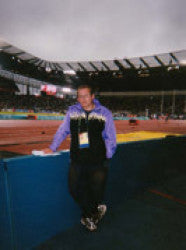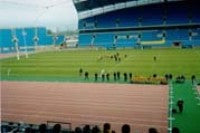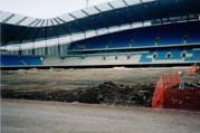Hosting the Commonwealth Games
Hosting the Commonwealth Games

The pitch inside the Commonwealth Games Stadium was intended to be temporary, therefore the construction was very basic - goal to goal drains, laid at about 9 metres centres within the hard core base; on top of that was 200mm of 6mm gravel and then a layer of 250 mm root zone. That was it!
There was some pop up irrigation in the surrounds of the pitch, although it was rarely needed in Manchester! The seed used was Barenbrug Bar Stadia, and the seeding took place in July 2001, following the above construction by Mallinsons of Ormskirk. Mallinsons were the contractors in charge of the playing surface and its maintenance. Following the grass establishment, the pitch was monitored and cut using only an ordinary garden tractor mower in the Autumn of last year.
I took over maintenance in late April of this year, working for John Mallinson. Prior to my arrival one of his lads had been coming in just to tip off the grass. The pitch had not had a cylinder mower on it up till then.

The following week I fertilised the pitch with some 12:6:6 granulated feed, approximately 250kg (10 bags) in total, and 4 weeks later put some more on. I had another test event, athletics, at the end of May with the televised athletics trials in mid-June. Every weekend in between there were rehearsals on the pitch for the opening and closing ceremonies, but these were conducted without sheets to protect the grass! The only time they used the
I had a nightmare time before the televised trial events because, for 9 days continuously, we had more than a thousand kids each day running and dancing on the pitch. It was during the World Cup, when the weather was good, so I had difficulty irrigating. I used to come into the stadium at midnight to set up the sprinklers. I was then back in to remove them from the pitch by 7.00am the next morning.
The pitch took quite a hammering - there were bare patches caused by the kids dancing on the spot and in small circles. I couldn't do a great deal in terms of preparation for the trials, so I just put some fresh grass clippings over the bare areas.
Even after the trials, I still had major difficulties getting access to the pitch. The ceremonial rehearsals were beginning to get serious with carpets being rolled out over the pitch. I wanted to do some over seeding, but I wasn't given the time to get it on. In fact there were lots of things I wanted to do but my hands were tied and I just had to do my best within the windows of time allocated.
I managed to borrow a Tri-king to get the grass cut quicker. In my opinion, a Mastiff creates a better finish but it is not fast enough. Some days I only had 2 hours to get my work done and with the Tri-king at least I could guarantee getting it mowed.
I also had to cope with the BBC setting up their cables; they had 6 cable ducts in the pitch. The BBC were followed by the Swiss timing people - we put in concrete posts for the photo finish which they decided, after the trials, were not in the right place, so we had to move them!

Vehicles, stages, carpets, plastic sheets, people were continuously on and off the pitch. As you can appreciate there was a lot of compaction, and we were only able to get on to vertidrain on one occasion in late June. We were not able to do any further significant work, no fertilising after that date. We did attempt to put on some liquid iron in July but the weather was too bad on the day allocated to us.
I realised early on that I was not going to get the grass as healthy as would have liked it to be, so I aimed to get it playing as well as possible and looking good for the TV. It was compacted, and out of my control, so I just kept on mowing to keep the stripes. The organisers were happy with the way it looked, but they weren't to know the ground was compacted or that there was Leafspot infesting itself everywhere.
I mowed and watered to keep it looking good, reseeded and top-dressed by hand - a bit of old fashioned Groundsmanship.
By necessity, I prepared more from a cosmetic rather than professional playing surface point of view. The lifespan for the pitch was to be only 10 days.
During the Games I was cutting the grass in the early hours of the morning, that's to say when I wasn't having an argument with someone or anyone claiming priority for the use of the pitch. One night in particular I had a blazing row with a French TV producer who was adamant he had booked the surface to film his show.
Generally though, I helped where necessary and tidied up the pitch after events such as the shot and the hammer. The treatment was similar to repairing a heel mark - raising the area around the hole to make a mound and levelling it off with the back of a spade. They 
The setting up for the Rugby sevens was quite a job because there had been a protective sheet on the pitch for more than 24 hours.
There was also some damage caused just off the pitch by a camera stand. On the morning of the first match the organiser insisted that the area be replaced, so we brought in a turf cutter and managed to re-turf. We finished 15 minutes before the kick-off.
 Since the event the turf has been stripped off and is to be put to good use by Manchester Council. The root zone and gravel has been taken away by the Mallinsons, and Irrigation Control have taken back their
Since the event the turf has been stripped off and is to be put to good use by Manchester Council. The root zone and gravel has been taken away by the Mallinsons, and Irrigation Control have taken back their
Working on the Commonwealth Games pitch was an honour and a unique experience. Like all Groundsmen, I worked long unsociable hours with scant recognition for what I did. I did my job to the best of my ability and, when it mattered, the pitch looked good and performed well. I'm happy with that.
